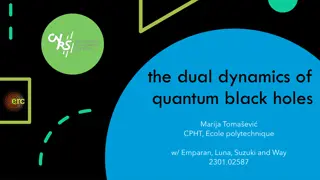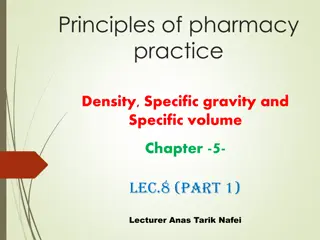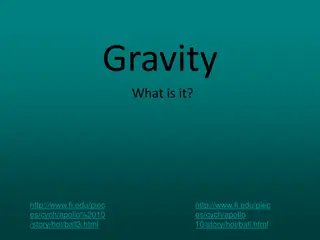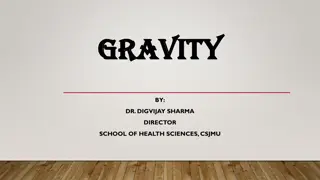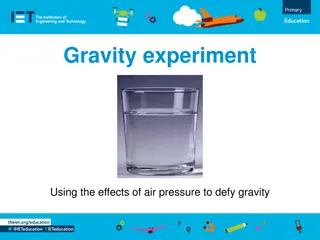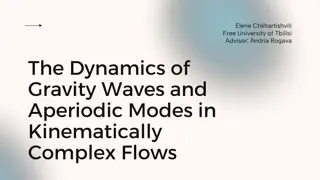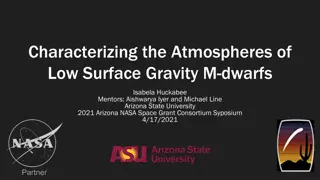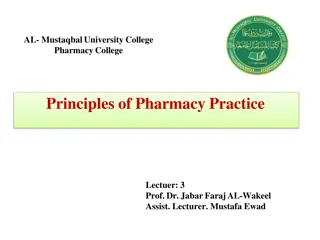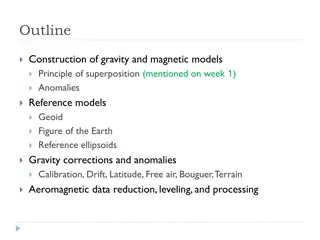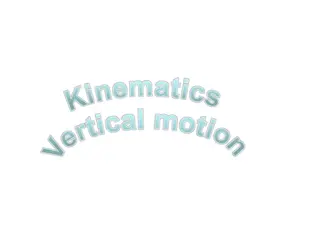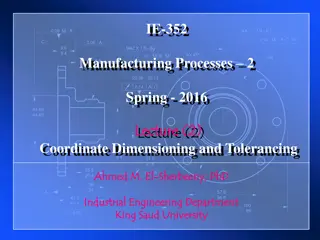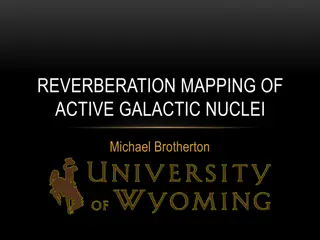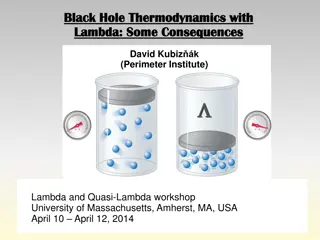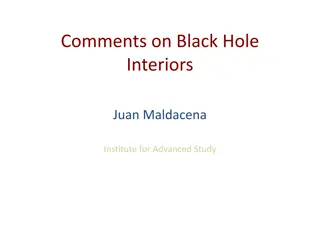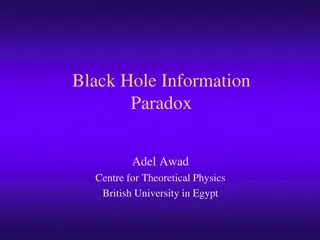Testing Extended Theories of Gravity Using Black Hole Shadows
Exploring the shadows of black holes as a method to test extended theories of gravity, this study discusses the existence of black holes, gravitational wave astronomy, and direct imaging. Researchers Oleg Zenin, Stanislav Alexeyev, Alexandra Nemtinova, and Artem Baiderin present findings on black hole shadows, including sizes and implications for gravitational theories.
Download Presentation

Please find below an Image/Link to download the presentation.
The content on the website is provided AS IS for your information and personal use only. It may not be sold, licensed, or shared on other websites without obtaining consent from the author.If you encounter any issues during the download, it is possible that the publisher has removed the file from their server.
You are allowed to download the files provided on this website for personal or commercial use, subject to the condition that they are used lawfully. All files are the property of their respective owners.
The content on the website is provided AS IS for your information and personal use only. It may not be sold, licensed, or shared on other websites without obtaining consent from the author.
E N D
Presentation Transcript
Black hole shadows as a source for testing extended theories of gravity Oleg Zenin (Faculty of Physics MSU) Stanislav Alexeyev (SAI MSU) Alexandra Nemtinova (Ural Federal University) Artem Baiderin (Faculty of Physics MSU)
1 3 2 Introduction Shadow model at A(r) B-1(r) Shadow model at A(r)=B-1(r) The existence of black holes was proven by: results on binary systems dynamics gravitational wave astronomy direct imaging of black hole The first recorded gravitational waves from the BH merger* * B.P. Abbott et al. Phys. Rev. D, 93(12):122003, 2016.
1 3 2 Introduction Shadow model at A(r) B-1(r) Sgr A* Shadow model at A(r)=B-1(r) M 87* BH shadow size from 4.3M to 5.3M BH shadow size from 4.3M to 6.1M K. Akiyama, et al., Astrophys. J. 875 (1) L5 (2019). The Event Horizon Telescope Collaboration, The Astrophysical Journal Letters 930 L17 (2022).
1 2 3 Shadow model at A(r)=B-1(r) Introduction Shadow model at A(r) B-1(r) Schwarzschild BH shadow*** Quasi Schwarzschild metric* Kerr BH shadow*** Sighting parameter Metric function** D=27M2 Q tidal or electric charge C3 third order coefficient Mass - normalized metric function *Cosimo Bambi. Phys. Rev. D, 87:107501, 2013. **S. Alexeyev, B. Latosh, V. Prokopov andE. Emtsova, J. Exp. Theor. Phys. 128 (5) 720(2019). ***https://odysseyedu.wordpress.com/black-hole-shadow/
1 2 3 Shadow model at A(r)=B-1(r) Introduction Shadow model at A(r) B-1(r) Prokopov V. A., Alexeyev S. O., O. Z., JETP. 2022. Vol. 135, no. 1. P. 91 99.
4 Horndeski Theory Prokopov V. A., Alexeyev S. O ., O. Z., JETP. 2022. Vol. 135, no. 1. P. 91 99.
5 Loop Quantum Gravity Prokopov V. A., Alexeyev S. O ., O. Z., JETP. 2022. Vol. 135, no. 1. P. 91 99.
6 Conformal Gravity if ?2=2, ??<0,9 Prokopov V. A., Alexeyev S. O ., O. Z., JETP. 2022. Vol. 135, no. 1. P. 91 99.
7 Bumblebee mode -0,05 < ? < 0,45 Prokopov V. A., Alexeyev S. O., Zenin O. I. Black hole shadows constrain extended gravity 2: Sgr a* // JETP. 2022.
8 f (Q) Gravity -0,025< <0,005 Prokopov V. A., Alexeyev S. O., Zenin O. I. Black hole shadows constrain extended gravity 2: Sgr a* // JETP. 2022.
9 Scalar Gauss-Bonnet gravity Dependences of the radius of the photonic sphere and the radius of BH shadowon the coupling parameter in the first order: Prokopov V. A., Alexeyev S. O ., O. Z., JETP. 2022. Vol. 135, no. 1. P. 91 99.
10 R+R2gravity The rotating metric obtained using the Newman-Janis algorithm by us: Hamilton-Jacobi Equation:
11 Rotating black hole simulation
12 Discussion and conclusions To fix a third-order correction, an intensity resolution of about 0.1% of the maximum intensity is required.
12 Discussion and conclusions To fix a third-order correction, an intensity resolution of about 0.1% of the maximum intensity is required. The results for the Horndeski model with the Gauss-Bonnet invariant, loop quantum gravity, Bambelby and Gauss-Bonnet scalar models are completely consistent with the observations of M87* and Sgr A*.
12 Discussion and conclusions To fix a third-order correction, an intensity resolution of about 0.1% of the maximum intensity is required. The results for the Horndeski model with the Gauss-Bonnet invariant, loop quantum gravity, Bambelby and Gauss-Bonnet scalar models are completely consistent with the observations of M87* and Sgr A*. In conformal gravity, large values of ??and ??should be excluded (for example, if ??=2, then ??<0.9). In STEGR ?(?) gravity observations M87* and Sgr A* limit the values of as follows: -0.025< <0.005. For an alternative generalization of the bumbelby metric with the Schwarzschild approximation: -0.05 < ? ? < 0.45. These results demonstrate the maximum that can be achieved without taking into account the rotation of the black hole.
12 Discussion and conclusions To fix a third-order correction, an intensity resolution of about 0.1% of the maximum intensity is required. The results for the Horndeski model with the Gauss-Bonnet invariant, loop quantum gravity, Bambelby and Gauss-Bonnet scalar models are completely consistent with the observations of M87* and Sgr A*. In conformal gravity, large values of ??and ??should be excluded (for example, if ??=2, then ??<0.9). In STEGR ?(?) gravity observations M87* and Sgr A* limit the values of as follows: -0.025< <0.005. For an alternative generalization of the bumbelby metric with the Schwarzschild approximation: -0.05 < ? ? < 0.45. These results demonstrate the maximum that can be achieved without taking into account the rotation of the black hole. At the moment, using the Newman-Janis algorithm, a rotating R+R2 metric has been obtained. Currently, black holes are being simulated with fixed quantum corrections. It is also planned to use the results of gravitational lensing of galactic clusters to test extended theories of gravity.
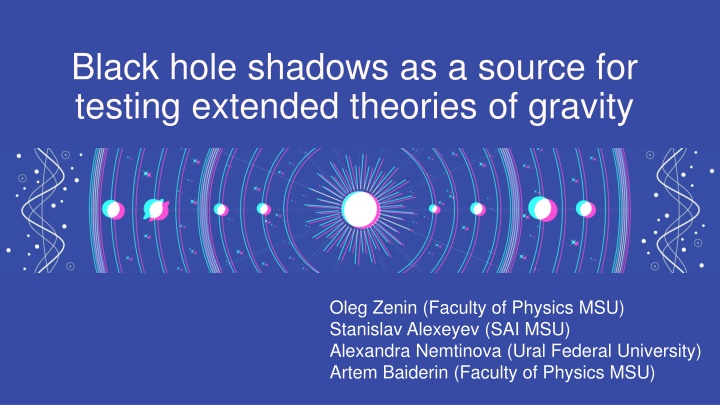


![[PDF⚡READ❤ONLINE] Black Hole Astrophysics: The Engine Paradigm (Springer Praxis](/thumb/21503/pdf-read-online-black-hole-astrophysics-the-engine-paradigm-springer-praxis.jpg)
